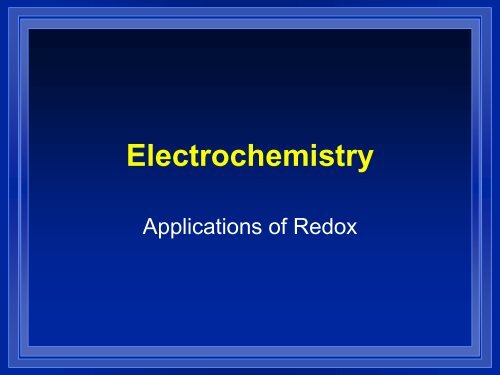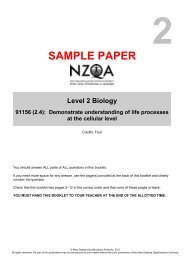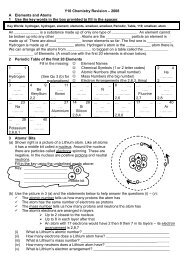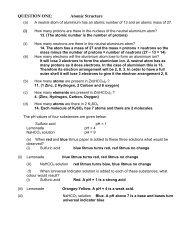You also want an ePaper? Increase the reach of your titles
YUMPU automatically turns print PDFs into web optimized ePapers that Google loves.
Electrochemistry<br />
Applications of Redox
Review<br />
• Oxidation reduction reactions involve a<br />
transfer of electrons.<br />
• OIL- RIG<br />
• Oxidation Involves Loss<br />
• Reduction Involves Gain<br />
• LEO-GER<br />
• Lose Electrons Oxidation<br />
• Gain Electrons Reduction
Applications<br />
• Moving electrons is electric current.<br />
• 8H + +MnO 4 - + 5Fe +2 +5e -<br />
Mn +2 + 5Fe +3 +4H 2 O<br />
• Helps to break the reactions into half<br />
reactions.<br />
• 8H + +MnO 4 - +5e - Mn +2 +4H 2 O<br />
• 5(Fe +2 Fe +3 + e - )<br />
• In the same mixture it happens without<br />
doing useful work, but if separate
• Connected this way the reaction starts<br />
• Stops immediately because charge builds<br />
up.<br />
H +<br />
MnO 4<br />
-<br />
Fe +2
<strong>Galvanic</strong> <strong>Cell</strong><br />
Salt<br />
Bridge<br />
allows<br />
current<br />
to flow<br />
H +<br />
MnO 4<br />
-<br />
Fe +2
• Electricity travels in a complete circuit<br />
H +<br />
e -<br />
MnO<br />
-<br />
Fe +2<br />
4
•Instead of a salt bridge<br />
Porous<br />
Disk<br />
H +<br />
MnO 4<br />
-<br />
Fe +2
e - e - e - e -<br />
Anode<br />
e -<br />
Reducing<br />
Agent<br />
Cathode<br />
e -<br />
Oxidizing<br />
Agent
<strong>Cell</strong> Potential<br />
• Oxidizing agent pulls the electron.<br />
• Reducing agent pushes the electron.<br />
• The push or pull (“driving force”) is called<br />
the cell potential E cell<br />
• Also called the electromotive force (emf)<br />
• Unit is the volt(V)<br />
• = 1 joule of work/coulomb of charge<br />
• Measured with a voltmeter
0.76<br />
H 2 in<br />
Anode<br />
Zn +2 H +<br />
SO<br />
-2 Cl -<br />
4<br />
1 M ZnSO 4<br />
Cathode<br />
1 M HCl
Standard Hydrogen Electrode<br />
• This is the reference<br />
all other oxidations<br />
are compared to<br />
•Eº = 0<br />
• º indicates standard<br />
states of 25ºC,<br />
1 atm, 1 M<br />
solutions.<br />
H +<br />
Cl -<br />
1 M HCl<br />
H 2 in
<strong>Cell</strong> Potential<br />
• Zn(s) + Cu +2 (aq) Zn +2 (aq) + Cu(s)<br />
• The total cell potential is the sum of the<br />
potential at each electrode.<br />
• Eº cell = Eº Zn Zn +2 + Eº Cu +2 Cu<br />
• We can look up reduction potentials in a<br />
table.<br />
• One of the reactions must be reversed,<br />
so change it sign.
<strong>Cell</strong> Potential<br />
• Determine the cell potential for a galvanic<br />
cell based on the redox reaction.<br />
• Cu(s) + Fe +3 (aq) Cu +2 (aq) + Fe +2 (aq)<br />
• Fe +3 (aq) + e - Fe +2 (aq)<br />
Eº = 0.77 V<br />
• Cu +2 (aq)+2e - Cu(s)<br />
• Cu(s) Cu +2 (aq)+2e -<br />
Eº = 0.34 V<br />
Eº = -0.34 V<br />
• 2Fe +3 (aq) + 2e - 2Fe +2 (aq) Eº = 0.77 V
Reduction potential<br />
• More negative Eº<br />
– more easily electron is added<br />
– More easily reduced<br />
– Better oxidizing agent<br />
• More positive Eº<br />
– more easily electron is lost<br />
– More easily oxidized<br />
– Better reducing agent
Line Notation<br />
• solidAqueousAqueoussolid<br />
• Anode on the leftCathode on the right<br />
• Single line different phases.<br />
• Double line porous disk or salt bridge.<br />
• If all the substances on one side are<br />
aqueous, a platinum electrode is<br />
indicated.
•For the last reaction<br />
•Cu(s)Cu +2 (aq)Fe +2 (aq),Fe +3 (aq)Pt(s)<br />
Cu 2+ Fe +2
In a galvanic cell, the electrode that<br />
acts as a source of electrons to the<br />
solution is called the __________;<br />
the chemical change that occurs at<br />
this electrode is called________.<br />
a. cathode, oxidation<br />
b. anode, reduction<br />
c. anode, oxidation<br />
d. cathode, reduction
Under standard conditions, which of<br />
the following is the net reaction that<br />
occurs in the cell?<br />
Cd|Cd 2+ || Cu 2+ |Cu<br />
a. Cu 2+ + Cd → Cu + Cd 2+<br />
b. Cu + Cd → Cu 2+ + Cd 2+<br />
c. Cu 2+ + Cd 2+ → Cu + Cd<br />
d. Cu + Cd 2+ → Cd + Cu 2+
<strong>Galvanic</strong> <strong>Cell</strong><br />
• The reaction always runs<br />
spontaneously in the direction that<br />
produced a positive cell potential.<br />
• Four things for a complete description.<br />
1) <strong>Cell</strong> Potential<br />
2) Direction of flow<br />
3) Designation of anode and cathode<br />
4) Nature of all the componentselectrodes<br />
and ions
Practice<br />
• Completely describe the galvanic cell<br />
based on the following half-reactions<br />
under standard conditions.<br />
• MnO 4 - + 8 H + +5e - Mn +2 + 4H 2 O<br />
Eº=1.51 V<br />
• Fe +3 +3e - Fe(s)<br />
Eº=0.036V
Batteries are <strong>Galvanic</strong> <strong>Cell</strong>s<br />
• Car batteries are lead storage batteries.<br />
• Pb +PbO 2 +H 2 SO 4 PbSO 4 (s) +H 2 O
Batteries are <strong>Galvanic</strong> <strong>Cell</strong>s<br />
• Dry <strong>Cell</strong><br />
Zn + NH 4 + +MnO 2 <br />
Zn +2 + NH 3 + H 2 O + Mn 2 O 3
Batteries are <strong>Galvanic</strong> <strong>Cell</strong>s<br />
• Alkaline<br />
Zn +MnO 2 ZnO+ Mn 2 O 3 (in base)
Batteries are <strong>Galvanic</strong> <strong>Cell</strong>s<br />
• NiCad<br />
• NiO 2 + Cd + 2H 2 O Cd(OH) 2 +Ni(OH) 2
Corrosion<br />
• Rusting - spontaneous oxidation.<br />
• Most structural metals have reduction<br />
potentials that are less positive than O 2 .<br />
• Fe Fe +2 +2e -<br />
• O 2 + 2H 2 O + 4e - 4OH -<br />
• Fe +2 + O 2 + H 2 O Fe 2 O 3 + H +<br />
• Reactions happens in two places.<br />
Eº= 0.44 V<br />
Eº= 0.40 V
Salt speeds up process by increasing<br />
conductivity<br />
Water<br />
Fe 2+<br />
Rust<br />
e -<br />
Iron Dissolves- O<br />
Fe Fe +2 2 + 2H 2 O +4e - 4OH -<br />
Fe 2+ + O 2 + 2H 2 O Fe 2 O 3 + 8 H +
Preventing Corrosion<br />
• Coating to keep out air and water.<br />
• Galvanizing - Putting on a zinc coat<br />
• Has a lower reduction potential, so it is<br />
more easily oxidized.<br />
• Alloying with metals that form oxide<br />
coats.<br />
• Cathodic Protection - Attaching large<br />
pieces of an active metal like magnesium<br />
that get oxidized instead.
Electrolysis<br />
• Running a galvanic cell backwards.<br />
• Put a voltage bigger than the potential<br />
and reverse the direction of the redox<br />
reaction.<br />
• Used for electroplating.
1.10<br />
e - e -<br />
Zn<br />
1.0 M<br />
Zn +2<br />
1.0 M<br />
Cu +2<br />
Cu<br />
Anode<br />
Cathode
e - A battery e -<br />
>1.10V<br />
Zn<br />
1.0 M<br />
Zn +2<br />
Cathode<br />
1.0 M<br />
Cu +2<br />
Anode<br />
Cu
A way to remember<br />
• An Ox – anode is where oxidation occurs<br />
• Red Cat – Reduction occurs at cathode<br />
• <strong>Galvanic</strong> cell- spontaneous- anode is<br />
negative<br />
• Electrolytic cell- voltage applied to make<br />
anode positive

















